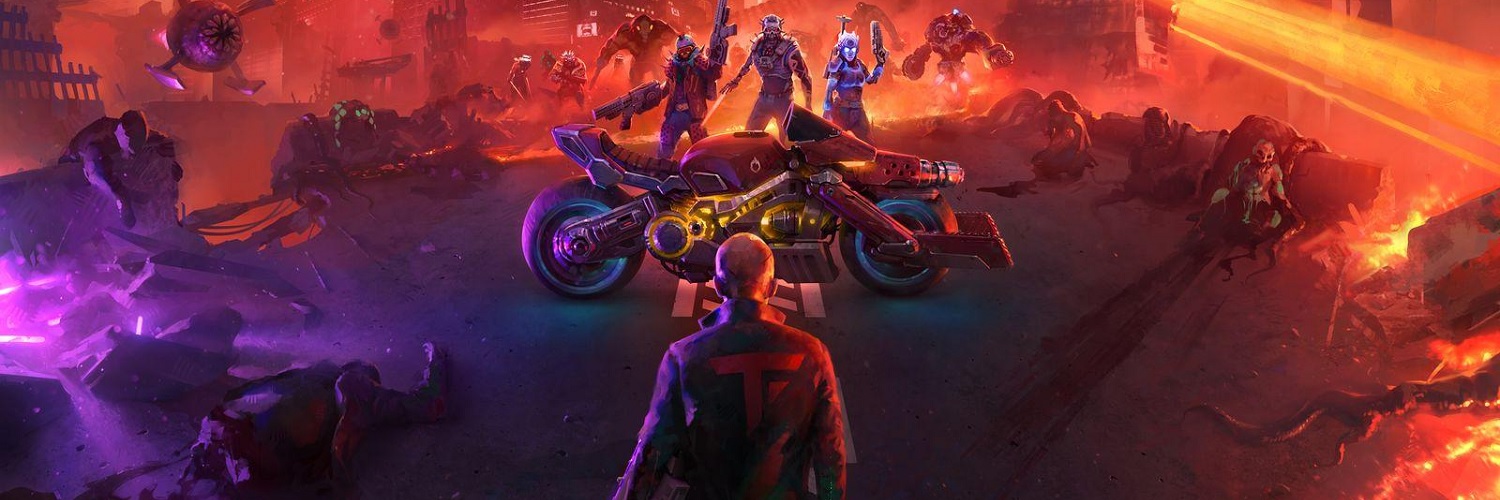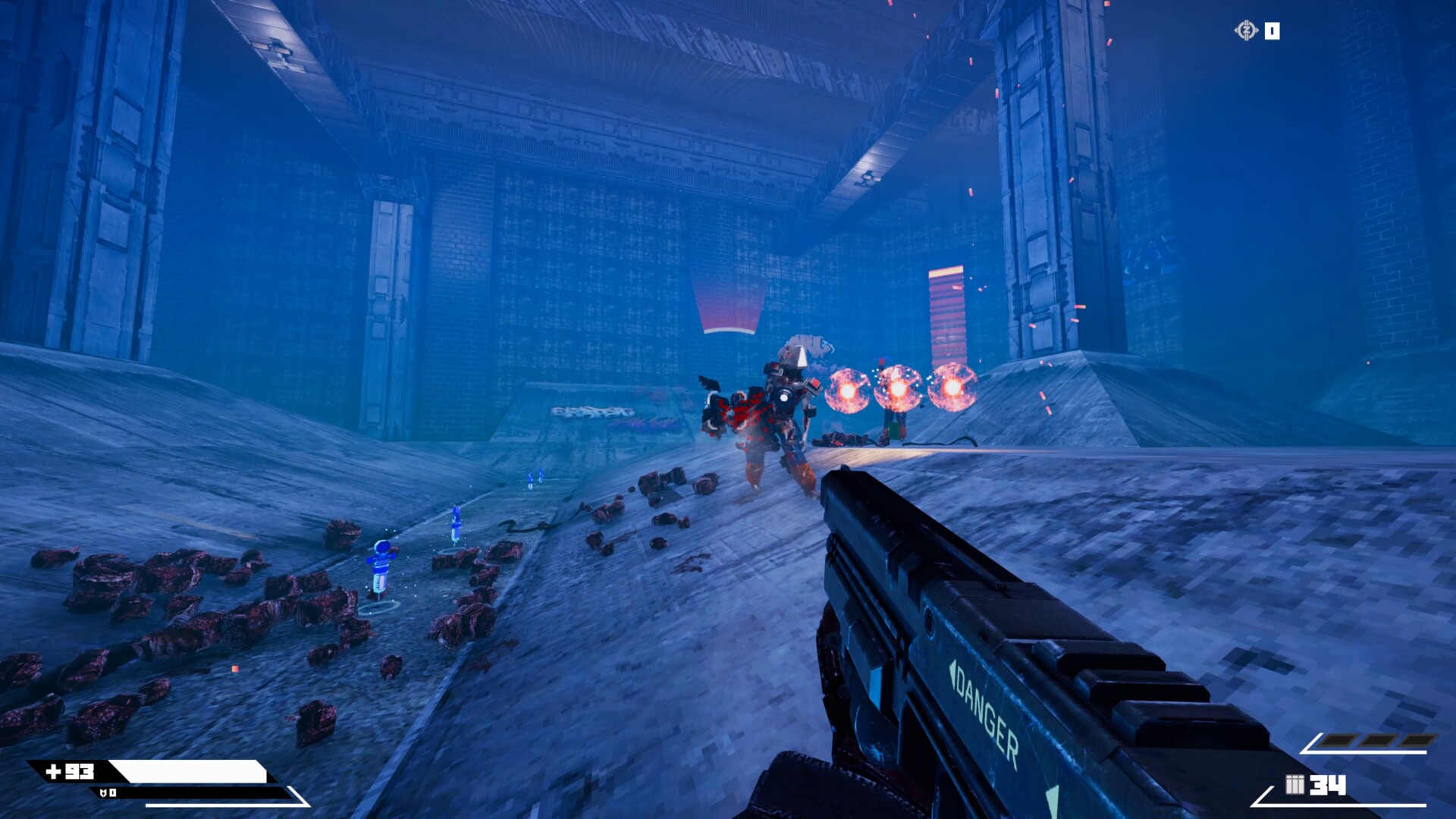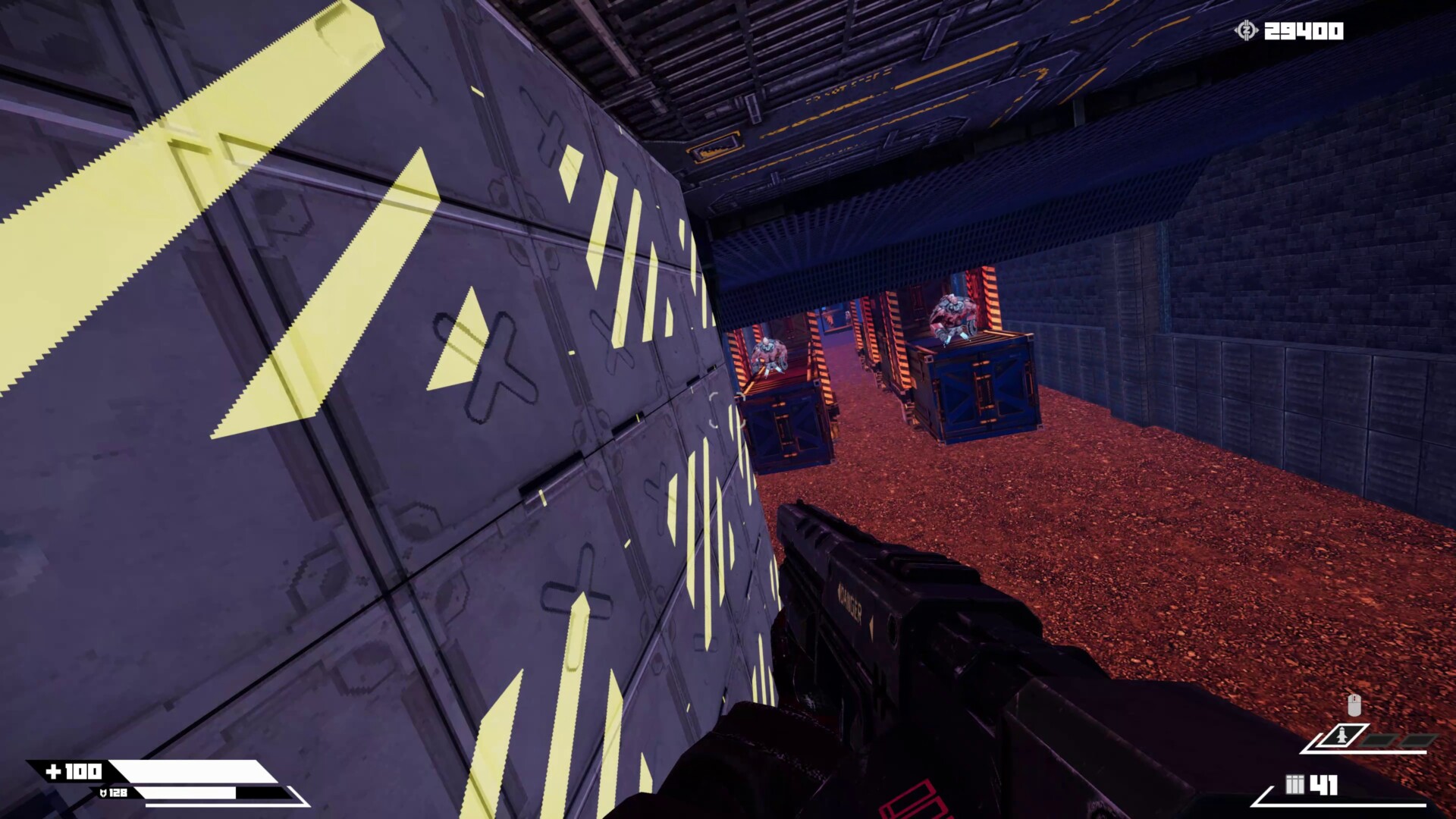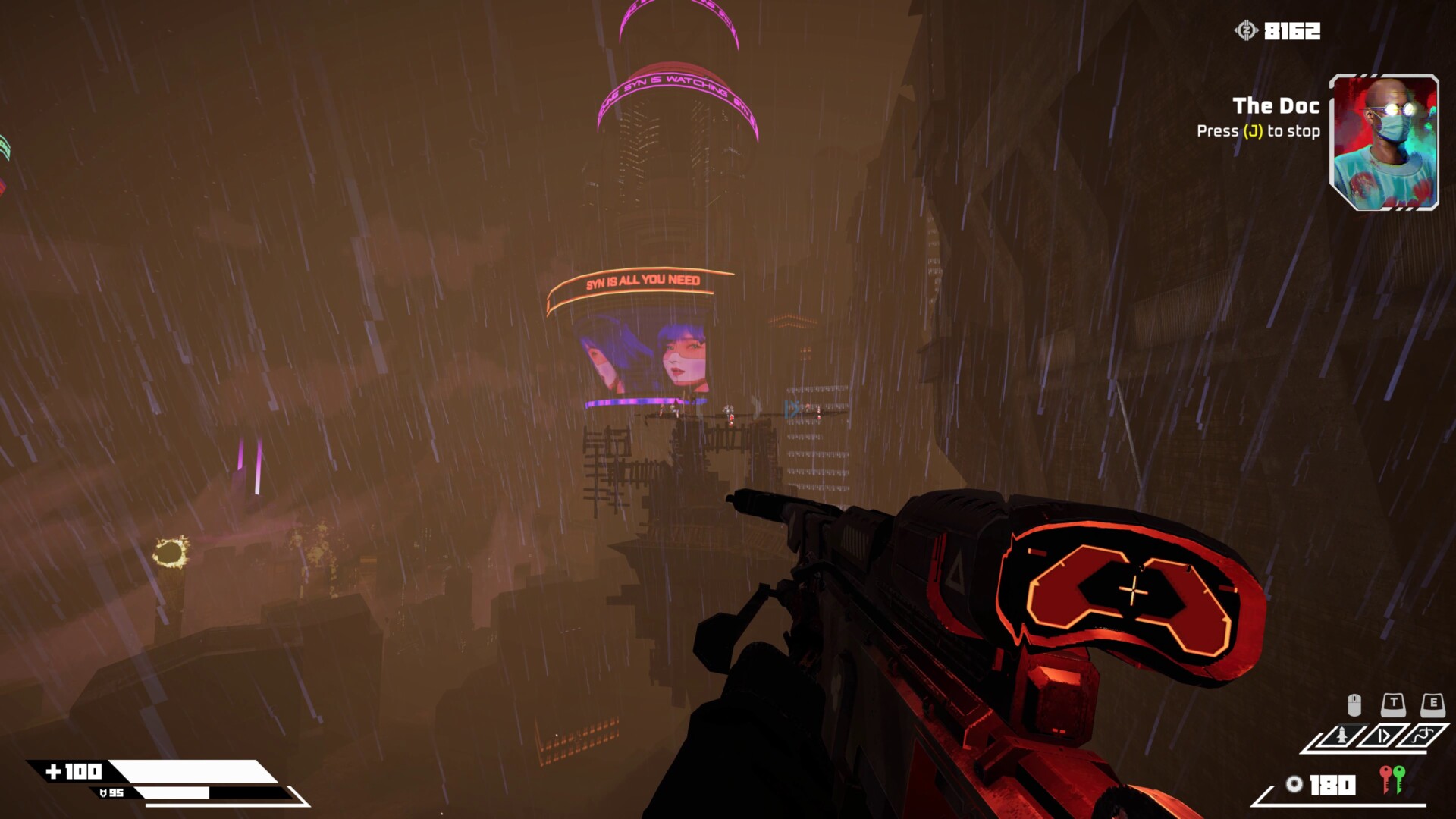
Turbo Overkill PC Review
There is no shortage of first-person shooters that capture the late 90s design and philosophy. I would even go as far to say that the quality has become so good that fans of such shooters have a great catalogue to play with, be it Ion Fury, Amid Evil or Prodeus, there is plenty to discover and enjoy in the subgenre of the first-person shooter that has been given the title “Boomer Shooter”.
Turbo Overkill is one such title that wants to join the collection. Once an Early Access release, Turbo Overkill comes out loud to fully load on any first-person shooter fan with its over-the-top action, an absurd story themed in a cyberpunk world and blending elements of old and new to create a sort of hybrid that aims for old school gameplay mixed with some ideas found in modern titles. Yet this all works so well for one heck of a shooter that becomes so stupid that I could not help but smile at its ridiculousness throughout the game’s three acts.

The premise is dumb, but intended as such, so let the game take you for the ride. It contains cyberpunk and augmented concepts (chainsaw hidden inside a leg, anyone?) that feel ripped straight from a group of story writers sat in a TV studio in the 90s thinking up their next cool action sci-fi TV show. Players are in the role of Johnny Turbo, a person who is half-metal, half-human, thanks to a run-in with a street cleaner (think bounty hunters) who wasted his human body. Johnny lives as an augmented hunter himself after that incident, now tasked to take on the AI, Syn, who has gone rogue and infected the entire population of the city and turned them into minions doing the AI’s bidding. Along with his AI wrist buddy, S.AM.M., a delightful entertaining AI that has known Johnny since he was young and adds many of the buddy cop-style moments in the game, Johnny must put a stop to the infection before Syn can grow enough to infest the entire planet and move itself outwards into the solar system. It is stupid, but I bloody love it. The developers clearly have a thing for this kind of stupendous stuff, as Turbo Overkill confidently expresses itself this way.
One of the first things that stuck with me when playing Turbo Overkill was its speed. This game’s movement is incredibly fast and responsive. Be it simply moving on the ground, jumping or dashing, the game’s feel of movement is brilliantly done. This is a title where air control feels not much different than jumping from the ground, which allows for near-perfect air control, abusing the secondary jump, wall jumps or dashes to avoid danger. There were many times in the later levels when the level design got more complex and open that I would fall off a platform, but react by double jumping up and dashing back to safety before a bottomless pit of doom could sallow Johnny’s mechanical bits. If you do succumb to falling, then it’s not death, just a little loss of life and back on solid ground to continue to madness. Sliding is also a form of movement, being that sliding is Johnny’s way of doing melee damage, as this brings out his chainsaw leg and deals damage on any foe it hits, shredding the basic enemies in one touch. While sliding, players can also shoot, allowing for great damage dealing while sliding into enemies. There are many times when the game’s level design sets it up perfectly for sliding and shooting enemies and watching them turn into a mass amount of blood and gore, as their parts rip off and blood drops from the ceiling in compact spaces after a good body gib explosion.

The fast responsive movement makes the gameplay of Turbo Overkill such a blast to take part in. At first, the level design is rather straightforward, as levels take place in industrial buildings within the cyberpunk city, looking like any standard indoor building in a first-person shooter, but when Act 1 clocks over is when the game really starts to shine with its level design. This is due to the tools that the player has unlocked further into the game and how the developers incorporate this into the level design. One of these levels introduces a flying car as traversal. The player drives this machine gun-wielding vehicle to get around skyscrapers, either flying into spaces that allow the vehicle through or jumping out of the car and going in on foot to continue with the objective. The flying car is great, as getting out situates the character on the roof of the vehicle, acting as a mobile platform to find secrets or entrances into buildings that are otherwise impossible without it. Let me tell you, there are some dastardly hidden secrets in this game that I do not think I beat a level having them all collected on the first completion.
Another level revolves around jumping on the roofs of fast-moving cars to progress to the end of a tunnel. This was the level that made me understand that the developers had the utmost confidence in their game’s controls for movement. Any mistake in missing a car can be corrected with the additional jump or dash. Levels just get crazier as the game goes on, to the point where the player is tasked to double jump, double dash, grab onto high-rising ladders, swing from ladder to ladder using grappling hooks or even throw in some jumps and dashes to be able to reach another grappling hook. The sheer scale of some of the levels is breathtaking and showcases what can be crafted when developers aren’t scared of causing platforming issues that some first-person shooters suffer from when trying to incorporate jump-focused level design. Each level feels like it is trying to one-up the previous one by adding in many outrageous moments, such as gliding into a window using the enemy’s intestines after blasting his body in half (check my shared tweet about this). There was also a level that felt ripped from Ghostrunner, what with all its wall running and grappling hook combinations to traversal across bottomless space pits.

But levels are not the only thing that makes up a great first-person shooter, what about the guns and the combat? Well on the guns side, this game packs a nice selection of some of the standard guns we expect to see, with each one having an alternative fire mode, which is unlocked and then later upgraded further into the campaign. When a game gives the player a dual magnum as their default gun, along with an alt fire that can lock onto a few enemies and instagib them, you just know the upcoming weapons are going to be brutal. There are shotguns, double barrel shotguns, uzis, and rocket launchers; the typical weapons. Their alt fires will change their properties. The minigun becomes a flamethrower, the uzi becomes an assault rifle, the double-barrel shotgun becomes a grenade launcher. One of my favourites is the alt-fire of the sniper rifle that has the ability to teleport the player into a person’s body and instakill them from the inside, leaving a lovely pile of body parts splattered against the floor.
The telefrag also adds another form of traversal, as there are many times enemies are away in the distance and using that weapon is a great way to close the gap. There is also a nice combat scenario featuring this weapon involving enclosed boxes high in the air, with each one featuring snipers ready to potshot the player. Another fantastic weapon is the Ion Cannon, which rains down a massive laser from the sky to melt any foe that is absorbed within its beam. It’s such fun moving the laser around while jumping around a battlefield, watching enemies explode in bloody goodness! The only issue I have is some of the sound effects for the weapons are a bit muted, especially the shotgun, as this does not sound like a powerful shotgun. I was expecting Terminator 2 audio, but what I got was some sounding peashooter echo.

Johnny’s chainsaw leg is not the only tool available to him. The already mentioned grappling hook can be upgraded so that it can be attached to enemies and set them ablaze when zipping at them. Other powers become accessible throughout the campaign, such as Micro Missiles, small explosives that lock onto enemies and are amazing at clearing out enemies. All these body augmentations can be altered through the spice vending machine, with many perks that can be plugged into them. For example, the chainsaw leg can be changed to reward armour on each hit, while the double jump can be altered to stick to walls like Spider-Man or enable explosions when falling from a great distance onto enemies. The Micro Missiles can be altered to drop frag grenades on explosion or increase their damage. There are many of these perks to find and each one has its fun that sometimes it is hard to pick between them.
Enemies litter every corner, as Turbo Overkill is not afraid to shower the player with foes to blast apart. Some will take damage easily, while others require less straightforward approach, such as shield enemies that will die instantly with a charged-up energy shotgun blast, or if fast enough, a few shots from the back with another gun, but the former is the more efficient way to take them out, more so as they seem to travel in groups and a well-placed charged shot will instantly remove their existence. There is a good mixture that I did not feel that there was ever a point where the enemy variety was too little. The game does good at introducing new foes to keep the encounters fresh. One thing I will note is that the AI is not great. This is a game that goes for simplicity, and these foes are not bright to the point they can be manipulated to get stuck on corners/raised blocks. They seem to be programmed with one thing in mind, killing Johnny and so they approach is more direct. When enemies are in front it’s fine to visualise what is happening, but it is hard to understand who is damaging the player when they are out of the camera view.

Once the campaign is done, there are five difficulties here, so plenty to challenge oneself. There are hidden secrets to discover in each level that unlock modifiers and secret levels. Each level tracks what secrets are discovered and what difficulty they were beaten on, allowing one to purposely pick a completed level and go back and do better. Outside of the campaign mode is Endless mode with many customisation options to tweak. This includes things like the difficulty, starting arenas, load-outs and powers/augmentations. Endless mode does what it says on the tin but goes a bit more than being a simple bolt-on to the game, as it uses the cash concept from defeating enemies and offers a shop every three stages to purchase upgrades. It’s a great distraction from the main game and allows the game’s bloody madness to shine as levels become more hectic with enemies, notably if the intensity is modified in the options.
Content does not stop there as the last feature is a level editor. There were already piles of options available to download that fans have created, so I can only imagine how insane this will become the longer the game has been out. I am not a creative person myself, so I’ll leave the level design to the people who can…although as you would expect, not every fan-made level is up to the standards of the best ones available.
With a name like Turbo Overkill, one is correct to assume that it is full of that cheesy madness, which is exactly what it delivers as it fully embraces the Boomer Shooter subgenre. Turbo Overkill is an encapsulation of absurdity, trying to push itself to the heights of stupendous fun through its creative weapons, augmentations and dumb, wild scenarios while offering plenty of mechanics and rapid gameplay to satisfy those old-school action lovers. With its superb throwback visuals, quality soundtrack, outlandish level design, and hyper-bloody action that never seems to let up, Turbo Overkill is a great recommendation for anyone looking for a quality and thrilling first-person shooter in 2023.
